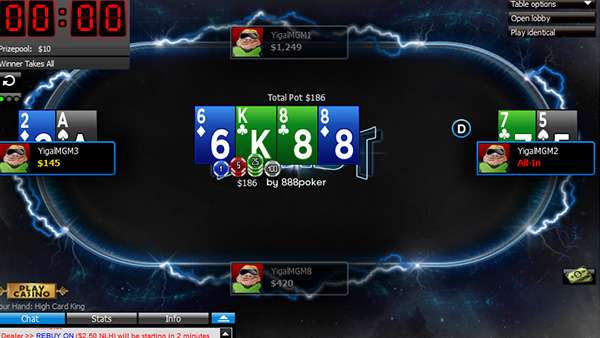888 Launches Blast Lottery Sit & Go’s
It has been a while since we talked about online poker Lottery Sit & Go’s, so today, let’s do just that. If you are on this site and especially if you are specifically reading this article, you probably know the drill on these tourneys by now. Nearly every internet poker site as their own version of the Lottery Sit & Go, headlines by PokerStars’ Spin & Go entry, but now and then, we keep seeing a new variation pop up. Such is the case with 888poker, the second largest online poker site in the world next to PokerStars, which recently introduced its version, the Sit & Go.
A typical Lottery Sit & Go is a three-handed, hyper-turbo, short-stacked contest (any more hyphenated poker lingo? No? Ok.) in which the prize pool is unknown to the players until the game starts. Once the three players pay their buy-in and take their seats, a graphic comes up to reveal what the prize pool will be, randomly generated based on a published probability table. At most sites, the prize pool will be only twice the buy-in about 70 to 75 percent of the time. Another 20 percent of the time or so, it will be four times the prize pool. The prize pool can be thousands or even tens of thousands of times the buy-in at its max, but those numbers hit a fraction of a fraction of a percent of the time, hence the “lottery” name for these games.
Lottery Sit & Go’s are mostly winner-take-all because they are only three handed, but some sites pay each player at the highest one, two, or three prize pool multiples, probably to avoid having players drop-kick their dogs when they finally get that once-in-a-lifetime shot at the jackpot (I really am using a lot of hyphens today) and can’t cash in.
When online poker rooms and networks have launched Lottery Sit & Go’s this year, they have tended to insert their own twist in order to differentiate their product and 888poker’s Blast is no different.
Blast games are four-handed, with buy-ins of $0.10, $1, $5, and $30. Just like with other Lottery Sit & Go’s, each buy-in level has a probability table for what the prize pool will be and that prize pool will not be revealed until all players are seated. Potential prize pool multipliers are 2x, 5x, 10x, 100x, 1,000x, and 10,000x.

888 Blast Sit & Go Table
Time’s up!
Where Blast really differs, though, is once the game begins. Every match has a time limit; if that time limit is reached, all remaining players are automatically put all-in until a winner is determined. The lower the prize pool multiplier, the shorter the time limit.
Blind levels, regardless of the prize pool multiplier, are two minutes each. For the 2x and 5x multipliers, there are only three blind levels, so the tournament can last for at most six minutes. The 10x multiplier has four blind levels (eight minutes max), at 100x there are five blind levels (ten minutes max – I know you appreciate that I’m doing the first grade arithmetic for you), and at the 1,000x and 10,000 multiplier levels, there are six blind levels (twelve minutes max).
One would assume the idea behind this is to make it so that players don’t have to spend too long competing for relatively small prizes, yet giving some more play when the prizes are more substantial. Lottery Sit & Go’s usually end fairly quickly, anyway, since the blinds increase so fast – this will simply put a cap on the time limit. It will be interesting to see how players respond to this: it could be nice to know that you will only have to commit “x” number of minutes to a game at most, but at the same time, the time limit could force people to play a little fast than they might like, even in such a briskly-paced game. Hopefully 888poker did all the proper calculations and testing to make sure that these time limits were reasonable.
As for the prize pool distribution, Blast Sit & Go’s are only winner-take-all at the lowest multiplier level. The 5x multiplier games pay to two places, three places are paid at 10x and 100x, and everyone makes something at the 1,000x and 10,000x levels.
The chances of the random number generator pulling up the 10,000x multiplier are 10 in a million, regardless of the buy-in. Similarly, the 1,000x multiplier has a 40 in a million frequency and the 100x multiplier has a 400 in a million frequency at every buy-in. The variations come in at the bottom three multipliers. In a nutshell, the higher the buy-in, the better the chance to hit the 10x multiplier.

















COMMENTS